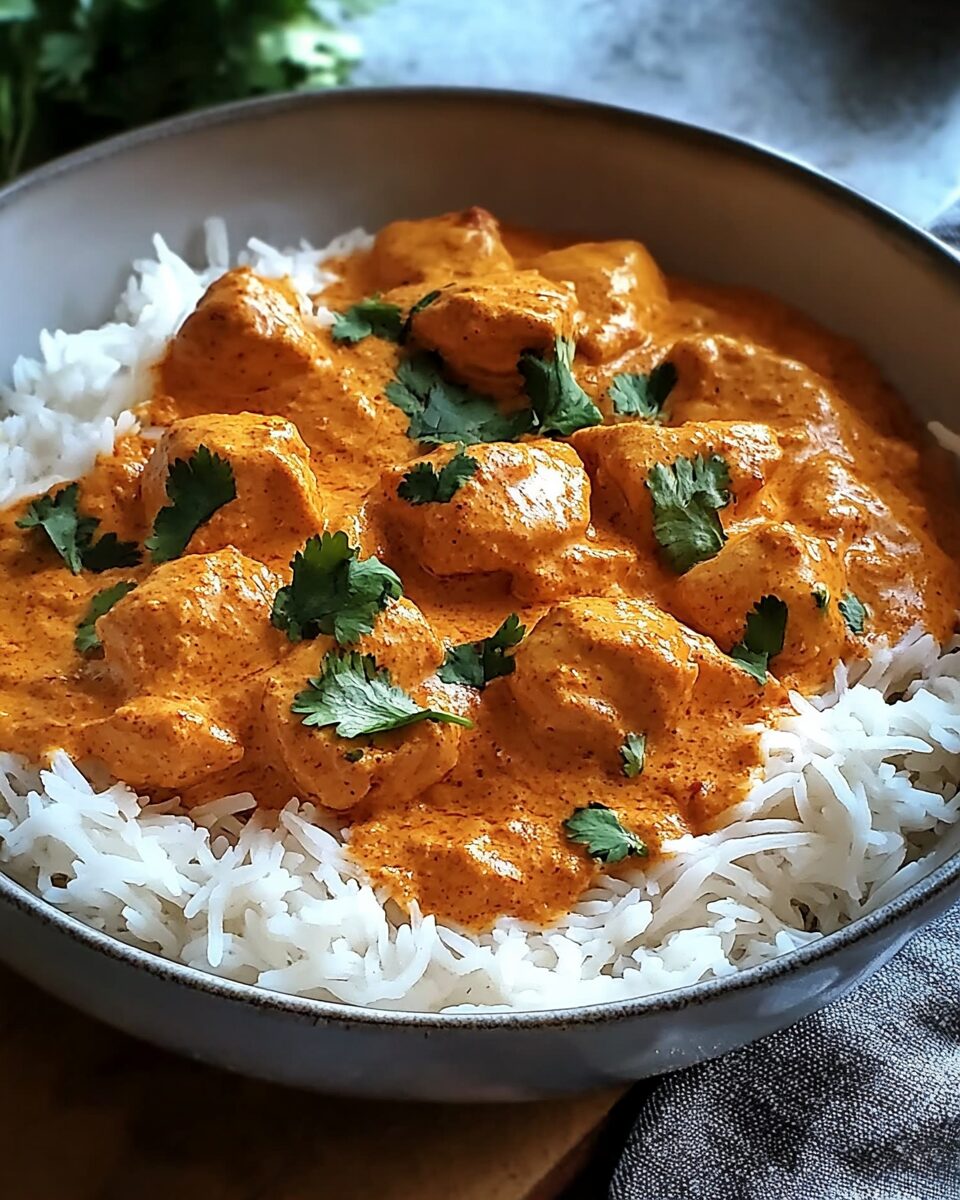Stovetop Indian Butter Chicken, also known as Murgh Makhani, is a beloved dish in Indian cuisine. This rich and creamy recipe features tender chicken pieces simmered in a flavorful tomato-based sauce infused with aromatic spices. It’s a comforting meal that’s perfect for dinner and can be prepared in just 30 minutes, making it ideal for busy weeknights or spontaneous gatherings.
Full Recipe:
Ingredients
Chicken
- 1 lb boneless, skinless chicken breasts or thighs, cut into bite-sized pieces
Aromatics
- 2 tablespoons unsalted butter
- 1 small onion, finely chopped
- 1 tablespoon fresh ginger, minced
- 3 cloves garlic, minced
Spices
- 1 tablespoon garam masala
- 1 teaspoon ground cumin
- 1/2 teaspoon ground turmeric
- 1 teaspoon ground coriander
- 1/2 teaspoon ground paprika
- 1/4 teaspoon cayenne pepper (optional)
Sauce
- 1 cup tomato sauce
- 1/2 cup heavy cream or coconut milk
- 1/4 cup plain yogurt
- 1 tablespoon lemon juice
- Salt and pepper, to taste
Garnish
-
Fresh cilantro, chopped
For Serving
-
Cooked basmati rice or naan
Directions
-
Sauté the Aromatics: In a large skillet over medium heat, melt the unsalted butter. Add the finely chopped onion and sauté until soft and translucent, about 3-4 minutes. Stir in the minced ginger and garlic, cooking for an additional minute until fragrant.
-
Cook the Chicken: Add the bite-sized chicken pieces to the skillet, seasoning with salt and pepper. Cook until the chicken is lightly browned on all sides and cooked through, approximately 5-6 minutes.
-
Add the Spices: Sprinkle in the garam masala, ground cumin, ground turmeric, ground coriander, ground paprika, and cayenne pepper if using. Stir well to coat the chicken evenly with the spices.
-
Prepare the Sauce: Pour in the tomato sauce, stirring to combine. Reduce the heat to low and let the mixture simmer for about 10 minutes, allowing the flavors to meld together.
-
Add Creaminess: Stir in the heavy cream or coconut milk, plain yogurt, and lemon juice. Continue to simmer for another 5 minutes, adjusting the seasoning with additional salt and pepper as needed.
-
Garnish and Serve: Remove the skillet from heat. Garnish the butter chicken with freshly chopped cilantro and serve hot over cooked basmati rice or with warm naan.
Nutritional Facts (per serving, serves 4)
- Calories: Approximately 350-400 kcal
- Protein: 30g
- Carbohydrates: 10g
- Fat: 20g
- Saturated Fat: 10g
- Cholesterol: 110mg
- Sodium: 600mg
- Fiber: 2g
- Sugar: 5g
Historical Origins
The inception of Butter Chicken dates back to the 1950s in Delhi, India. Kundan Lal Jaggi, along with his partners Kundan Lal Gujral and Thakur Das Magu, established the Moti Mahal restaurant in Daryaganj, Delhi, after migrating from Peshawar during the Partition of India. Faced with the challenge of repurposing leftover tandoori chicken, they devised a method of simmering the pieces in a tomato-based gravy enriched with butter and cream, resulting in the creation of Butter Chicken. This innovative approach not only minimized food waste but also introduced a dish that would soon become iconic.
Cultural Significance
Butter Chicken embodies the resilience and creativity of Indian culinary traditions, particularly in the context of post-Partition India. Its creation symbolizes the fusion of diverse culinary practices brought together during a period of cultural amalgamation. The dish’s widespread popularity has made it a unifying element across various regions and communities, often serving as an introductory experience to Indian cuisine for many around the world. Its rich, yet approachable flavor profile appeals to a broad audience, bridging cultural and gastronomic divides.
Global Popularity and Adaptations
The international journey of Butter Chicken is a testament to its universal appeal. As Indian diaspora communities established themselves globally, they carried this culinary gem to new shores. In countries like Canada and the Caribbean, Butter Chicken has been creatively incorporated into dishes such as pizza, poutine, wraps, and rolls. In Australia and New Zealand, it has found its way into pie fillings, showcasing the dish’s adaptability. These variations highlight the seamless integration of Butter Chicken into diverse culinary traditions, reflecting its versatility and enduring popularity.
Perfect Pairings
To enjoy Butter Chicken at its best, pairing it with the right accompaniments is essential. Traditionally, basmati rice and freshly baked naan bread are the most common choices, allowing the rich gravy to be soaked up fully. Flavored rice varieties, such as jeera (cumin) rice or saffron-infused rice, also elevate the dining experience. A side of cucumber raita or kachumber salad brings a refreshing contrast that balances the richness of the dish.
Nutritional Profile
While Butter Chicken is indulgent, understanding its nutritional aspects can aid in making informed dietary choices. A typical serving provides a substantial amount of protein due to the chicken content. However, the inclusion of butter and cream contributes to higher levels of saturated fats and calories. For those mindful of their dietary intake, moderating portion sizes and pairing the dish with healthier sides can help balance the meal. Additionally, incorporating lean cuts of chicken and opting for reduced-fat dairy alternatives can make the dish more aligned with health-conscious preferences.
Healthier Variations
As dietary trends evolve, so do versions of Butter Chicken. For those seeking lighter options, ingredients like low-fat yogurt, almond milk, or coconut cream are substituted to reduce calorie and fat content. Vegetarian and vegan adaptations using paneer, tofu, or even chickpeas are also becoming mainstream. These variants maintain the essential flavor elements while offering inclusive alternatives for a wider range of dietary preferences.
Why It Remains a Classic
Butter Chicken has stood the test of time because it satisfies on multiple levels—flavor, texture, and comfort. Its consistency in flavor, ease of preparation, and ability to please a diverse audience make it a dependable choice. It is equally suited to festive celebrations and quiet home dinners, offering a sense of warmth and familiarity. Its ability to inspire both nostalgia and curiosity ensures that it remains a mainstay in kitchens for generations to come.
Conclusion
Butter Chicken’s journey from a resourceful creation in a Delhi restaurant to a globally cherished dish underscores its culinary brilliance and cultural significance. The evolution of Butter Chicken from a practical way to reuse leftovers into a restaurant menu staple illustrates the power of innovation in Indian cooking. What began as an experiment in resourcefulness has become a global brand. The dish’s development parallels India’s own modern history—surviving cultural shifts, global migration, and increasing international influence. It stands as an enduring example of how food can both preserve tradition and embrace change. Its rich history, combined with its adaptability and universal appeal, cements its status as a timeless classic in the world of gastronomy.






